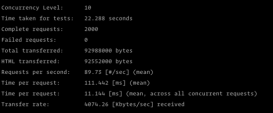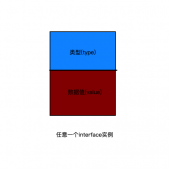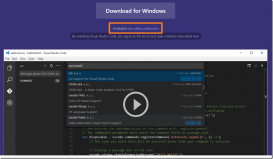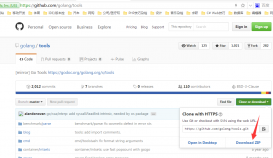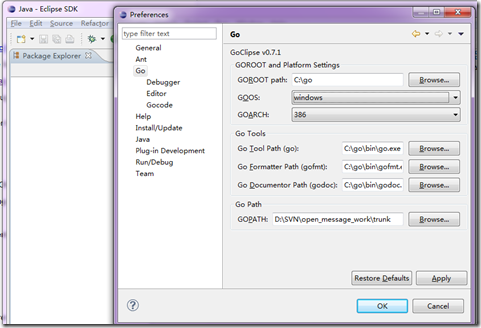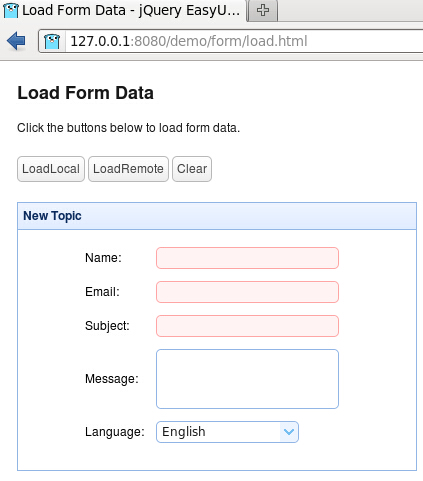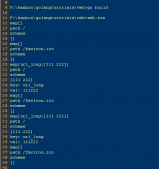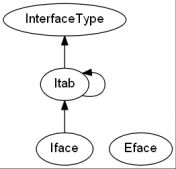1.简介
Container — 容器数据类型:该包实现了三个复杂的数据结构:堆、链表、环
-
List:Go中对链表的实现,其中List:双向链表,Element:链表中的元素 -
Ring:实现的是一个循环链表,也就是我们俗称的环 -
Heap:Go中对堆的实现
2.list
简单实用:
|
1
2
3
4
5
6
7
8
9
10
11
12
13
|
func main() { // 初始化双向链表 l := list.New() // 链表头插入 l.PushFront(1) // 链表尾插入 l.PushBack(2) l.PushFront(3) // 从头开始遍历 for head := l.Front();head != nil;head = head.Next() { fmt.Println(head.Value) }} |
方法列表:
|
1
2
3
4
5
6
7
8
9
10
11
12
13
14
15
16
17
18
19
20
21
|
type Element func (e *Element) Next() *Element // 返回该元素的下一个元素,如果没有下一个元素则返回 nil func (e *Element) Prev() *Element // 返回该元素的前一个元素,如果没有前一个元素则返回niltype List func New() *List // 返回一个初始化的list func (l *List) Back() *Element // 获取list l的最后一个元素 func (l *List) Front() *Element // 获取list l的第一个元素 func (l *List) Init() *List // list l 初始化或者清除 list l func (l *List) InsertAfter(v interface{}, mark *Element) *Element // 在 list l 中元素 mark 之后插入一个值为 v 的元素,并返回该元素,如果 mark 不是list中元素,则 list 不改变 func (l *List) InsertBefore(v interface{}, mark *Element) *Element // 在 list l 中元素 mark 之前插入一个值为 v 的元素,并返回该元素,如果 mark 不是list中元素,则 list 不改变 func (l *List) Len() int // 获取 list l 的长度 func (l *List) MoveAfter(e, mark *Element) // 将元素 e 移动到元素 mark 之后,如果元素e 或者 mark 不属于 list l,或者 e==mark,则 list l 不改变 func (l *List) MoveBefore(e, mark *Element) // 将元素 e 移动到元素 mark 之前,如果元素e 或者 mark 不属于 list l,或者 e==mark,则 list l 不改变 func (l *List) MoveToBack(e *Element) // 将元素 e 移动到 list l 的末尾,如果 e 不属于list l,则list不改变 func (l *List) MoveToFront(e *Element) // 将元素 e 移动到 list l 的首部,如果 e 不属于list l,则list不改变 func (l *List) PushBack(v interface{}) *Element // 在 list l 的末尾插入值为 v 的元素,并返回该元素 func (l *List) PushBackList(other *List) // 在 list l 的尾部插入另外一个 list,其中l 和 other 可以相等 func (l *List) PushFront(v interface{}) *Element // 在 list l 的首部插入值为 v 的元素,并返回该元素 func (l *List) PushFrontList(other *List) // 在 list l 的首部插入另外一个 list,其中 l 和 other 可以相等 func (l *List) Remove(e *Element) interface{} // 如果元素 e 属于list l,将其从 list 中删除,并返回元素 e 的值 |
2.1数据结构
节点定义:
|
1
2
3
4
5
6
7
8
9
10
|
type Element struct { // 后继指针,前向指针 next, prev *Element // 链表指针,属于哪个链表 list *List // 节点value Value interface{}} |
双向链表定义:
|
1
2
3
4
5
6
|
type List struct { // 根元素 root Element // sentinel list element, only &root, root.prev, and root.next are used // 实际节点数量 len int // current list length excluding (this) sentinel element} |
初始化:
|
1
2
3
4
5
6
7
8
9
|
// 通过工厂方法返回list指针func New() *List { return new(List).Init() }func (l *List) Init() *List { l.root.next = &l.root l.root.prev = &l.root l.len = 0 return l} |
这里可以看到root节点作为一个根节点,不承担数据,也不是实际的链表节点,节点数量len没算上它,再初始化的时候,root节点会成为一个只有一个节点的环(前后指针都指向自己)
2.2插入元素
头插法:
|
1
2
3
4
5
6
7
8
9
10
11
|
func (l *List) Front() *Element { if l.len == 0 { return nil } return l.root.next}func (l *List) PushFront(v interface{}) *Element { l.lazyInit() return l.insertValue(v, &l.root)} |
尾插法:
|
1
2
3
4
5
6
7
8
9
10
11
|
func (l *List) Back() *Element { if l.len == 0 { return nil } return l.root.prev}func (l *List) PushBack(v interface{}) *Element { l.lazyInit() return l.insertValue(v, l.root.prev)} |
在指定元素后新增元素:
|
1
2
3
4
5
6
7
8
9
|
func (l *List) insert(e, at *Element) *Element { e.prev = at e.next = at.next e.prev.next = e e.next.prev = e e.list = l l.len++ return e} |
这里有个延迟初始化的逻辑:lazyInit,把初始化操作延后,仅在实际需要的时候才进行
|
1
2
3
4
5
|
func (l *List) lazyInit() { if l.root.next == nil { l.Init() }} |
移除元素:
|
1
2
3
4
5
6
7
8
9
10
|
// remove 从双向链表中移除一个元素e,递减链表的长度,返回该元素e func (l *List) remove(e *Element) *Element { e.prev.next = e.next e.next.prev = e.prev e.next = nil // 防止内存泄漏 e.prev = nil // 防止内存泄漏 e.list = nil l.len -- return e } |
3.ring
Go中提供的ring是一个双向的循环链表,与list的区别在于没有表头和表尾,ring表头和表尾相连,构成一个环
使用demo:
|
1
2
3
4
5
6
7
8
9
10
11
12
13
14
15
16
|
func main() { // 初始化3个元素的环,返回头节点 r := ring.New(3) // 给环填充值 for i := 1;i <= 3;i++{ r.Value = i r = r.Next() } sum := 0 // 对环的每个元素进行处理 r.Do(func(i interface{}) { sum = i.(int) + sum }) fmt.Println(sum)} |
方法列表:
|
1
2
3
4
5
6
7
8
9
|
type Ring func New(n int) *Ring // 初始化环 func (r *Ring) Do(f func(interface{})) // 循环环进行操作 func (r *Ring) Len() int // 环长度 func (r *Ring) Link(s *Ring) *Ring // 连接两个环 func (r *Ring) Move(n int) *Ring // 指针从当前元素开始向后移动或者向前(n 可以为负数) func (r *Ring) Next() *Ring // 当前元素的下个元素 func (r *Ring) Prev() *Ring // 当前元素的上个元素 func (r *Ring) Unlink(n int) *Ring // 从当前元素开始,删除 n 个元素 |
3.1数据结构
环节点数据结构:
|
1
2
3
4
|
type Ring struct { next, prev *Ring // 前继和后继指针 Value interface{} // for use by client; untouched by this library} |
初始化一个环:后继和前继指针都指向自己
|
1
2
3
4
5
|
func (r *Ring) init() *Ring { r.next = r r.prev = r return r} |
初始化指定数量个节点的环
|
1
2
3
4
5
6
7
8
9
10
11
12
13
14
|
func New(n int) *Ring { if n <= 0 { return nil } r := new(Ring) p := r for i := 1; i < n; i++ { p.next = &Ring{prev: p} p = p.next } p.next = r r.prev = p return r} |
遍历环,对个元素执行指定操作:
|
1
2
3
4
5
6
7
8
|
func (r *Ring) Do(f func(interface{})) { if r != nil { f(r.Value) for p := r.Next(); p != r; p = p.next { f(p.Value) } }} |
4.heap
Go中堆使用的数据结构是最小二叉树,即根节点比左边子树和右边子树的所有值都小
使用demo:需要实现Interface接口,go中堆都是实现这个接口,定义了排序,插入和删除方法
|
1
2
3
4
5
|
type Interface interface { sort.Interface Push(x interface{}) // add x as element Len() Pop() interface{} // remove and return element Len() - 1.} |
实现接口:
|
1
2
3
4
5
6
7
8
9
10
11
12
13
14
15
16
17
18
19
20
21
22
23
24
25
26
27
28
29
30
31
32
33
34
35
|
// An IntHeap is a min-heap of ints.type IntHeap []intfunc (h IntHeap) Len() int { return len(h) }func (h IntHeap) Less(i, j int) bool { return h[i] < h[j] }func (h IntHeap) Swap(i, j int) { h[i], h[j] = h[j], h[i] }func (h *IntHeap) Push(x interface{}) { // Push and Pop use pointer receivers because they modify the slice's length, // not just its contents. *h = append(*h, x.(int))}func (h *IntHeap) Pop() interface{} { old := *h n := len(old) x := old[n-1] *h = old[0 : n-1] return x}// This example inserts several ints into an IntHeap, checks the minimum,// and removes them in order of priority.func Example_intHeap() { h := &IntHeap{2, 1, 5} heap.Init(h) heap.Push(h, 3) fmt.Printf("minimum: %d\n", (*h)[0]) for h.Len() > 0 { fmt.Printf("%d ", heap.Pop(h)) } // Output: // minimum: 1 // 1 2 3 5} |
4.1数据结构
上浮:
|
1
2
3
4
5
6
7
8
9
10
11
12
13
14
15
|
func Push(h Interface, x interface{}) { h.Push(x) up(h, h.Len()-1)}func up(h Interface, j int) { for { i := (j - 1) / 2 // parent if i == j || !h.Less(j, i) { break } h.Swap(i, j) j = i }} |
下沉:
|
1
2
3
4
5
6
7
8
9
10
11
12
13
14
15
16
17
18
19
20
21
22
23
24
25
26
|
func Pop(h Interface) interface{} { n := h.Len() - 1 h.Swap(0, n) down(h, 0, n) return h.Pop()}func down(h Interface, i0, n int) bool { i := i0 for { j1 := 2*i + 1 if j1 >= n || j1 < 0 { // j1 < 0 after int overflow break } j := j1 // left child if j2 := j1 + 1; j2 < n && h.Less(j2, j1) { j = j2 // = 2*i + 2 // right child } if !h.Less(j, i) { break } h.Swap(i, j) i = j } return i > i0} |
到此这篇关于Go container包的介绍的文章就介绍到这了,更多相关Go container包内容请搜索服务器之家以前的文章或继续浏览下面的相关文章希望大家以后多多支持服务器之家!
原文链接:https://blog.csdn.net/weixin_41922289/article/details/121592261



